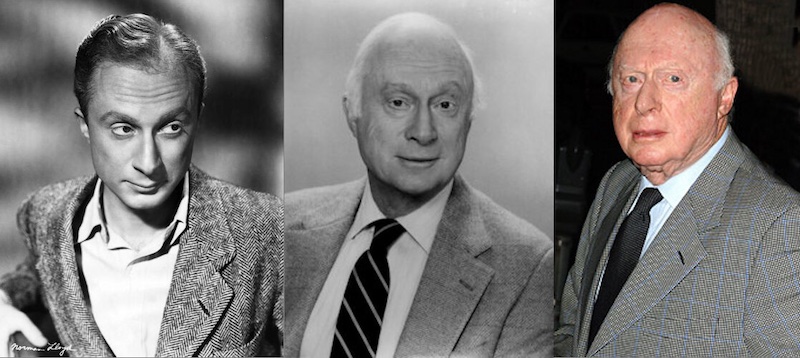Sponsored by By Title Only
America’s largest companies have a big problem. A disappearing problem.
More than half of the Fortune 500 companies in the year 2000 are no longer around.
Even more, only 10% of the companies from 1955’s Fortune 500 are still on the list today.
Only ten percent!!!
90% of those so-called “successful” companies either went bankrupt, were acquired, or otherwise cease to exist.
WTF?!
Being on the Fortune 500 means you’re a successful company, right? So why are they disappearing faster than an origami sailboat in the Bermuda Triangle?!
As it turns out, I know the answer. And, as it also turns out, said answer is pretty essential to the way you live your life.
But first, before we get there, you need to know about Norman Lloyd.

The Short Version of the Long Story about Norman Lloyd
Norman Lloyd was born in 1914 to a fairly average family. His father was a furniture salesman, his mother a housewife. He had two sisters but they play no part in the story so I’m not sure why I’m even mentioning them. Can I take that sentence back?
(Editors Note: No backsies)
Norman liked performing.
By 1923, when he was 9 years old, Norman appeared in vaudeville and other assorted places. This marked his official beginning as a professional actor.
By the time Norman turned 21, he was cast in his first Broadway play.
Then, at the ripe old age of 28 years old, Norm met a chap named Alfred Hitchcock and began a long professional association with him.
Next thing he knew, Norman started getting cast in more films. He worked with Charlie Chaplin, Orsen Wells, and Elia Kazan, among others.
Pretty neat for the kid of a furniture salesman, right?
Well, that’s not why I told you this story. In fact, the story isn’t even done.
Norman kept working. And working. And working. He didn’t stop.
He became a producer. He was a director. He worked in theater, film, TV, and radio. He acted in projects as diverse as Dead Poets Society, St. Elsewhere, The Twilight Zone, and Star Trek.
The last film he appeared in was Trainwreck. He was 99 years old. Norman died in 2021 at the age of 106.
Why is this important for you to know?
Because Norman Lloyd’s career lasted almost a century. He had the longest professional career in entertainment. Longer than anyone else in history…. by far.
And this brings us right back to the Fortune 500.

Success at the Top of the Mountain
There’s a problem with success. (It’s actually the same problem people have with Mt. Everest.)
Success feels good.
Hell, success feels great.
But that’s not the problem.
After all, we each want to achieve success, amirite? I mean, isn’t that the objective?
We set goals for ourselves and when we reach those goals, well, that is the very definition of success.
Achieving your goal feels f-ing awesome. The bigger and more audacious your goals, the more f-ing awesome the feeling is when you achieve them.
That’s kind of what those Fortune 500 companies felt like when they achieved unparalleled success.
They got to the top of the mountain.
And that was their problem.
Successfully Complacent
The bigger your success, the more proud you are of it. It’s natural to stand at the top of the mountain and wave your arms in joy.
You’ve accomplished big things. You’ve done it. You’ve climbed the mountain and now stand on the top.
It’s that feeling of standing on top of the world that often filters away many of the attributes that led you to success in the first place.
When you become the best, it’s easy to think that all the things you did to achieve success are the same things you should do to maintain it.
That’s wrong. Very wrong.
That type of thinking is what causes large companies to fail.
In the insightful words of Intel kabillionaire, Andy Grove:

Complacent and Complicit
Being complacent means believing that no matter what you do, you’ll remain king of the mountain. It means believing that the things that got you this far, will build you further.
They won’t.
No matter how big you are, no matter how long you’re standing in the top spot, a whole lot of other people are going to be laser-focused on taking you down. And if you don’t pay attention, they will succeed.
Just ask 90% of the Fortune 500 companies from 1955 about that.
Here’s the one thing you need to do in order to not stay complacent:
Be like Norman Lloyd.
Tackling Complacency: What Would Norman Do?
In a recent article I talked about the stacked S-Curve. If you didn’t read that, you should. Don’t make me smack you upside the head.
Norman Lloyd is the very embodiment of stacked S-Curves. If you want to know how to keep moving forward, it’s best to study the person who moved forward the longest.
Norman reached a peak when he started being cast in Broadway plays. After all, that’s the pinnacle for many people. But not Norman.
He reached that peak, then reinvented himself.
Norman then began acting in movies. He reached another peak when he started working with Alfred Hitchcock, and Charlie Chaplin. That would be the pinnacle for many people. Just not Norman.
He reached that peak, then reinvented himself.
He began directing, and producing. He then moved to radio. And then TV. And on and on.
You see, the greatest longest-lasting companies, are the ones that continually reinvent themselves and continually reach larger peaks.
There is no summit of the mountain.
There is no finish line.
There are only new plateaus and new opportunities to reinvent yourself.
A lot of companies have done really crappy jobs at that. Kodak failed. Sears failed. RadioShack failed.
They became successful. They became complacent. They failed.
What does this have to do with you? Well, let’s address that in the next section..
The Next Section
It is so easy to get caught up in the humdrum murmur of everyday life. It’s so easy to succumb to complacency.
I bet you had some big goals before. Maybe you achieved them, maybe you didn’t. The question is, have you become complacent in your life? Are you still working towards achieving new goals?
Or do you feel velcroed to the mundane? Sure you can break through, but it feels like it requires too much effort.
Here’s the problem: regrets are born out of complacency. And gosh dang-diddly, I don’t want you to have regrets.
So let me tell you what I do every year and sometimes have my leadership coaching clients do too. Heck, maybe you want to as well. It doesn’t have an official name but I call it “My Goals” cause that seems kinda catchy.

My Your Goals
Open up a Word doc, or Notion or Evernote, or whatever you use to make notes. Heck, use a chisel and stone if you want. I really don’t care.
Here’s what you’re gonna do. You’re going to write each of the following 4 questions down and you’re going to answer each one in just 2 or 3 sentences.
1. WHAT is your main goal?
For instance, “I want to weigh x pounds. I want to feel fit and healthy.”
2. WHY do you want to achieve that goal?
For instance, “I want to feel energized and focused. I want to feel positive about myself.”
3. HOW do you plan to achieve the goal?
For instance, “I will exercise for at least 20 minutes, five days per week. I will be mindful of what I eat.”
4. Imagine you’ve accomplished the goal, HOW DO YOU FEEL?
For instance, “I feel confident in my ability to achieve my goals. I feel great about my body and my mind. I feel like I can accomplish anything I set my mind to. I am happy and successful.”
—
Great!
Now merge all your answers together in a statement from the perspective of as if you’ve already achieved the goal.
Here’s what the above example would look like.
—-
I weigh x pounds. I feel fit and healthy. I feel energized and focused. I feel positive about myself. I exercise for at least 20 minutes each day five days per week. I am mindful of what I eat.
I feel confident in my ability to achieve my goals. I feel great about my body and my mind. I feel like I can accomplish anything I set my mind to. I am happy and successful.
——
Now print that statement out.
Put it by your bedside. Read it every morning when you wake up and every night before you go to sleep.
Simply visualizing your goal and your steps to get there becomes a powerful process to challenge the gravity of complacency.
Seriously. It’s a little thing that goes a long, long way.
Be intentional of what you are doing and why you are doing it. 90% of Fortune 500 companies lost their dreams. I don’t want you to.
It’s time for you to be the 10%.
It’s time for you to be Norman Lloyd.
Success is a decision.
The decision is yours.
A Somewhat Relevant Quote
“If complacency is bad for business, it can also be bad for the human spirit.“
Simon Silva, Latino artist
Random News
Overdraft – When you get a bill for $100b
Rolling Rocks – The strangest National Park rules
Femaile – AI is replacing women
Pass – Create a password, I dare you

